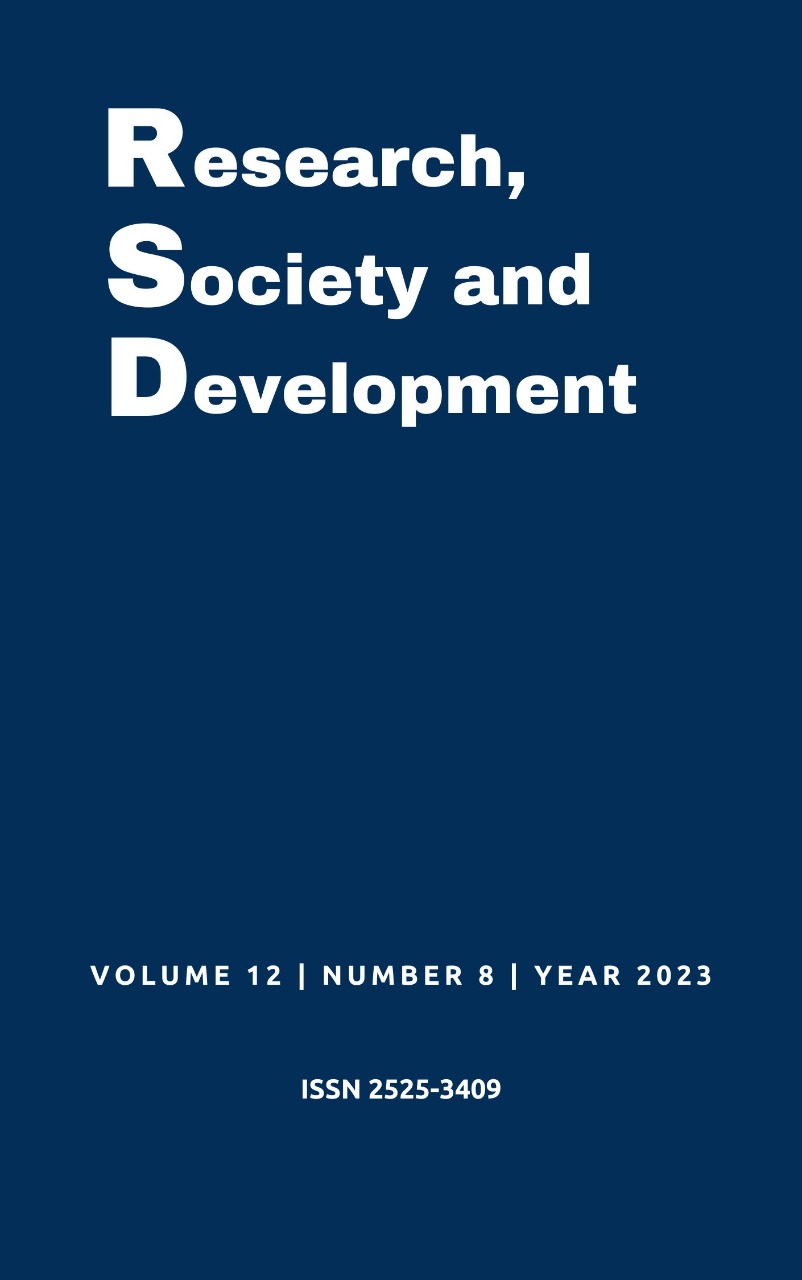Should we be concerned about accessory mandibular foramina and canals? A cone-beam computed tomography study
DOI:
https://doi.org/10.33448/rsd-v12i8.42950Keywords:
Mandible, Anatomic variation, Cone-Beam Computed Tomography.Abstract
Objective: Analyze the prevalence of mandibular accessory foramina and canals using cone-beam computed tomography (CBCT). Methodology: 136 mandibles divided into 10 predetermined areas were analyzed through CBCT looking for accessory foramina and canals. The Chi-square and Wilcoxon tests were used. Results: We found 1.316 accessory foramina, which 486 were accompanied by canals. 70.3% of accessory foramina were on the internal mandibular surface, most below the mylohyoid line and genial tubercles. The M1 area had the highest number of foramina, especially in the internal surface. The right mandibular side revealed a significantly greater number of foramina when compared to the left side. The mean diameter of accessory foramina analyzed was 0.85mm. Most of the accessory canals were on the internal mandibular surface, with a longer average length when compared to external surface canals. Conclusion: Our study showed that more detailed studies of accessory mandibular foramina and canals should be carried out, since a high prevalence of these structures and they have not named or classified yet. Furthermore, procedures that reach the internal mandibular surface, especially the anterior region, may be more subject to complications, as well as failure of anesthetic blocks on the right side of the mandible.
References
Bremer, G. (1952). Measurements of special significance in connection with anesthesia of the inferior alveolar nerve. Oral Surgery, Oral Medicine, Oral Pathology, 5, 966–988.
Fanibunda, K. & Matthews, J. N. S. (1999). Relationship between accessory foramina and tumor spread in the lateral mandibular surface. Journal of Anatomy, 195, 185-190.
Fanibunda, K. & Matthews, J. N. S. (2000). The relationship between accessory foramina and tumor spread on the medial mandibular surface. Journal of Anatomy, 196, 23-29.
Frommer, J., Mele, F. A., & Monroe, C. W. (1972). The possible role of the mylohyoid nerve in mandibular posterior tooth sensation. Journal of the American Dental Association, 85, 113–117.
Haveman, C. W. & Tebo, H. G. (1976). Posterior accessory foramina of the human mandible. Journal of Prosthetic Dentistry, 35, 462-468.
Katakami, K., Mishima, A., Shiozaki, K., Shimoda, S., Hamada, Y., & Kobayashi, K. (2008). Characteristics of accessory mental foramina observed on limited cone-beam computed tomography images. Journal of Endodontics, 34, 1441-1445.
Madeira, M. C., Percinoto, C., & Silva, M. G. M. (1978). Clinical significance of supplementary innervation of the lower incisor teeth: A dissection study of mylohyoid nerve. Oral Surgery, Oral Medicine, Oral Pathology, 46, 608-614.
Mendoza, C. C., Vasconcelos, B. C. E., Sampaio, G., Cauás, M., & Batista, J. E. M. (2004). Localização topográfica do forame mandibular: estudo comparativo em mandíbulas humanas secas. Revista de Cirurgia e Traumatologia Buco-Maxilo-Facial, 4(2), 137-142.
Meyer, T. N., Lemos, L. M., Nascimento, C. N. M., & Lellis, W. R. R. (2007). Effectiveness of nasopalatine nerve block for anesthesia of maxillary central incisors after failure of the anterior superior alveolar nerve block technique. Brazilian Dental Journal, 18, 69-73.
Muley P., Kale L., Choudhary S., Aldhuwayhi S., Thakare A., & Mallineni S.K. (2022). Assessment of accessory canals and foramina in the mandibular arch using cone-beam computed tomography and a new classification for mandibular accessory canals. Biomed Res Int, 2022, 5542030. https://doi.org/10.1155/2022/5542030.
Murlimanju, B. V., Prabhu, L. V., & Prameela, M. D. (2011). Accessory mandibular foramina: prevalence, embryological basis, and surgical implications. Journal of Clinical and Diagnostic Research, 5, 1137-1139.
Narayana, K. & Prashanthi, N. (2003). Incidence of large accessory mandibular foramen in human mandibles. European Journal of Anatomy, 7, 139-141.
Przystanska, A., & Bruska, M. (2010). Accessory mandibular foramina: histological and immunohistochemical studies of their contents. Archives of Oral Biology, 55, 77-80.
Przystanska, A. & Bruska, M. (2012). Anatomical classification of accessory foramina in human mandibles of adults, infants, and fetuses. Anatomical Science International, 87, 141-143.
Rood, J. P. (1977). The nerve supply of the mandibular incisor region. British Dental Journal, 143, 227–230.
Sisman, Y., Sahman, H., Sekerci, A. E., Tokmak, T. T., Aksu, Y., & Mavili, E. (2012). Detection and characterization of the mandibular accessory foramen using CT. Dentomaxillofacial Radiology, 41, 558-563.
Soto, R., Cáceres, F., & García, R. (2012). Presencia y morfometría de forámenes y canales en relación a las espinas mentonianas. International Journal of Morphology, 30 (2), 417-421.
Stein, P., Brueckner, J. & Milliner, M. (2007). Sensory innervation of mandibular teeth by the nerve to the mylohyoid: implications in local anesthesia. Clinical Anatomy, 20, 591-595.
Sutton, R. N. (1974). The practical significance of mandibular accessory foramina. Australian Dental Journal, 19, 167-173.
Wilson, S., Johns, P. I., & Fuller, P. M. (1984). Accessory innervation of mandibular anterior teeth in cats. Brain Research, 298, 392–396.
Downloads
Published
Issue
Section
License
Copyright (c) 2023 Maria Clara Avila de Oliveira; Marilza do Carmo Oliveira; Bruno Henrique Figueiredo Matos; Alexandre Augusto Sarto Dominguette

This work is licensed under a Creative Commons Attribution 4.0 International License.
Authors who publish with this journal agree to the following terms:
1) Authors retain copyright and grant the journal right of first publication with the work simultaneously licensed under a Creative Commons Attribution License that allows others to share the work with an acknowledgement of the work's authorship and initial publication in this journal.
2) Authors are able to enter into separate, additional contractual arrangements for the non-exclusive distribution of the journal's published version of the work (e.g., post it to an institutional repository or publish it in a book), with an acknowledgement of its initial publication in this journal.
3) Authors are permitted and encouraged to post their work online (e.g., in institutional repositories or on their website) prior to and during the submission process, as it can lead to productive exchanges, as well as earlier and greater citation of published work.


